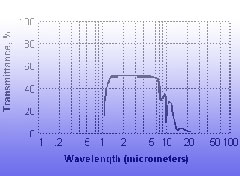硅(Silicon,简称Si)
Silicon is used as an optical window primarily in the 3 to 5 micron band and as a substrate for production of optical filters. It is frequently used for laser mirrors because of its high thermal conductivity and low density. Silicon is also useful as a transmitter in the 20 micron range. Large blocks wi th polished faces are also employed as targets in neutron physics experiments .Silicon is grown by Czochralski pulling techniques (CZ) and contains some oxygen which causes an absorption band at 9 microns. To avoid this, material can be prepared by a Float-Zone (FZ) process. Optical silicon is generally lightly doped ( 5 to 40 ohm cm) for best transmission above 10 microns. Silicon has a further pass band 30 to 100 microns which is effective only in very high resistivity uncompensated material.


OPTICAL
Transmission Range .......................................................................1.2 to 15 microns
Refractive Index .........................................................................3.4223 at 5 microns
Reflection Loss ........................................................46.2% at 5 microns (2 surfaces)
Restrahlen Peak ..............................................................1 x 10-3 cm-1 at 3 microns
dN/dT ...............................................................................................160 x 10-6e/°C
dN/dμ = 0 ......................................................................................................10.4μm
PHYSICAL
Density ....................................................................................................2.33 g/cm3
Melting Point ................................................................................................1420°C
Thermal Conductivity ............................................................163.3 W/(m*K) at 273K
Thermal Expansion ...........................................................................4.15 x 10-6/°C
Hardness Knoop................................................................................................ 1150
Specific Heat Capacity............................................................................. 703J/(kg K)
Dielectric Constant ................................................................................13 at 10GHz
Young's Modulus (E) ....................................................................................131 GPa
Shear Modulus (G)...................................................................................... 79.9 GPa
Bulk Modulus (K) ..........................................................................................102 GPa
Elastic Coefficients .....................................................C11 = 167 C12 = 65 C44 = 80
Poisson Ratio................................................................................................... 0.266
CHEMICAL
Solubility ......................................................................................Insoluble in water
Molecular Weight .............................................................................................28.09
Class/Structure ......................................................................Cubic diamond, Fd3m
REFRACTIVE INDEX
..............3.94(1.40μm), 3.48(1.50μm), 3.47(1.66μm), 3.46(1.82μm), 3.46(2.05μm),
3.44(2.50μm ), 3.44(3.50-5.00μm ), 3.42(6.00-25.00μm )


